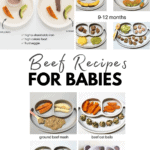This post may contain affiliate links. Please see our disclosure policy for more details.
Beef can safely be offered to babies as one of their first foods! Whether you are doing purees, baby led weaning, or both, here are some easy and age-appropriate ways to serve beef to babies.
“This post is a collaboration with Beef. It’s What’s for Dinner. managed by NCBA, a contractor to the Beef Checkoff. I received compensation, but all opinions are my own,”
When to introduce beef to babies
Short answer. As soon as your baby is ready to start solids, generally around 6 months.
You may have been advised to start with infant cereal, then fruits and vegetables, and then meat. According to the American Academy of Pediatrics and the newly released Dietary Guidelines for Americans 2020-2025, these recommendations have evolved.

Is your baby 6 months old and up?
Learn all the secrets to starting solids safely while optimizing nutrition!
Every Bite Counts
Did you know that proper nutrition during the first 1000 days (the period beginning at conception to two years of life) has a profound impact on your child’s brain development, lifelong health and eating habits?
During this critical time, babies have high nutritional needs to support their incredibly rapid growth and development. However, their tummies are tiny and so we need to make every bite count.
It’s up to us parents to make sure we provide them with foods that contain the essential nutrients that breast milk or formula can’t fully provide from 6 months and beyond.
While all nutrients are beneficial, these nutrients are particularly important.
Iron for Babies
In this post, I want to highlight the utmost importance of iron.
Iron is essential for a baby’s brain development and is a critical component of blood cells that deliver oxygen to tissues and other cells throughout the body.
- Starting at around 6 months, baby’s stores of nutrients, such as iron and zinc, decrease while their nutritional requirements increase drastically.
- Neither human breast milk nor infant formula alone is sufficient to meet the baby’s nutritional needs.
Unfortunately, research shows that many infants are falling short in meeting their iron needs.
And this is why the American Academy of Pediatrics, the Women Infants and Children’s Program and now for the first time ever, the Dietary Guidelines for Americans recommend introducing foods with iron, like beef, as one of baby’s first foods.
Beef as Early Baby Food
Baby cereal has for a long time been recommended as a first food is because it’s fortified with iron. However, it’s fortified with non-heme iron, which is not as easily absorbed as the heme iron found in meat, poultry, and seafood.
Iron in beef is highly absorbable, making it one of the best ways to meet iron needs for babies. Not only that, it also contains other essential nutrients like protein, zinc, and choline.
This is not to say you should only offer animal sources of iron as there are many plant sources of iron as well. However, since they’re not well absorbed, your baby will need to eat a large amount to help meet their needs. And that poses a challenge since not much food gets eaten when first starting solids.
Additionally, this phase isn’t just about providing energy and nutrition. Introducing solid foods is also important for developing acceptance of different food textures and flavors and laying down the foundation for healthy eating habits.
Beef offers new and different flavors and textures that will help support oral and motor development and encourage plenty of exploration during mealtimes.
How to Cook Beef for Baby
6-8 Months
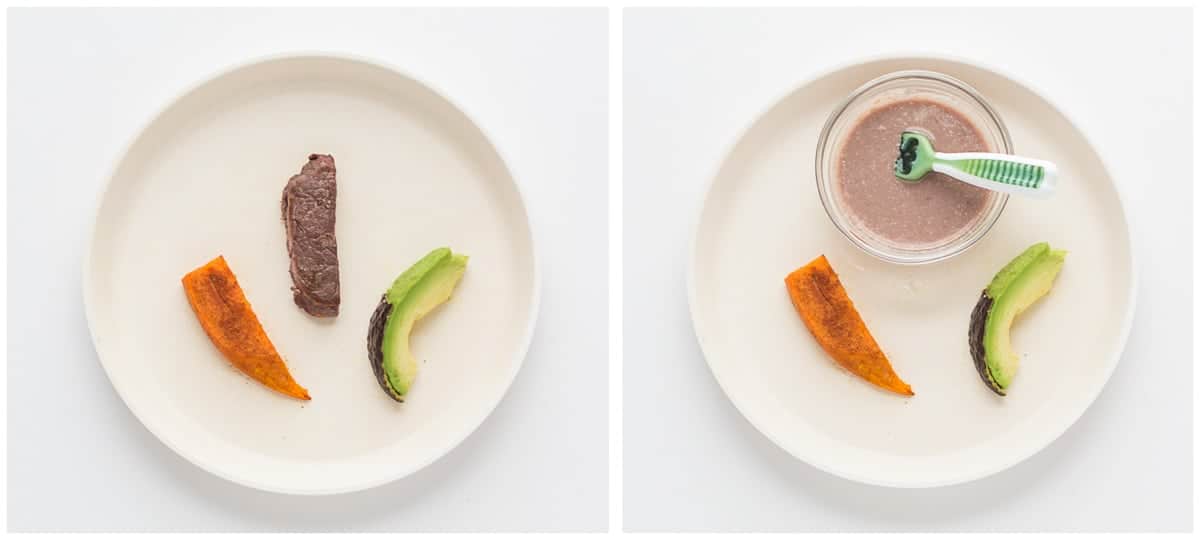
- Beef Puree – cook ground beef and puree with broth, water, or breastmilk. Serve on its own or mixed with veggies. And don’t forget to add seasonings. Babies LOVE flavor!
Do keep in mind, it’s important to move forward with texture by 9 months at the latest. Here’s how to transition baby from puree to table food.
Your baby does not need teeth to eat meat or any other finger food for that matter. You’ll be amazed by how strong and capable their gums are. Here’s an in-depth post on how to start baby led weaning.
- Steak strips – At this age, babies grab food with their palms so it’s better (and safer) to go bigger in size. Cook the beef until the thickest part reaches 160F. Then cut (against the grain) to a size and length of two adult fingers together. Baby will suck on the juices which are a source of much-needed iron.

- Meatballs – ground beef is so versatile, convenient, and budget-friendly. Combine it with vegetables and various spices, and it’s the perfect finger food for beginner eaters. Again, bigger is better at this age so serve them whole or slice in half. You can also shape them into logs or patties.
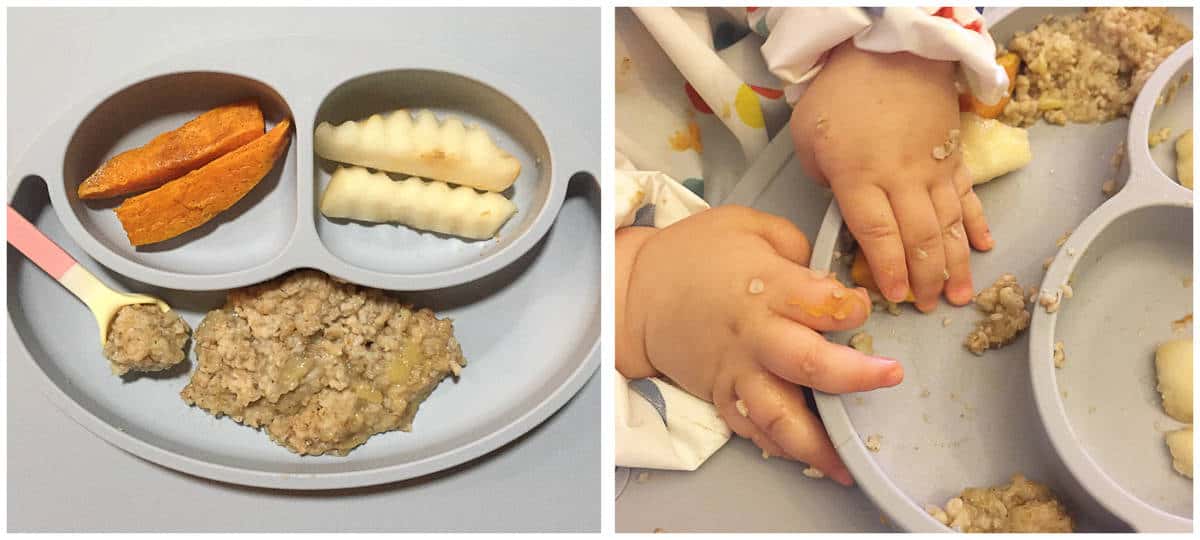
- Ground beef mash – cook the beef and mix it into scoopable, soft foods, like mashed potatoes, oatmeal, yogurt, mashed avocado, dips/sauces, etc. You can also flavor the beef, like in this Korean Bulgogi.
Try combining with oatmeal or lentils and shape into fingers!
9-12 months
- Steak strips – As baby starts to bite off chunks, it’s important to make sure the beef is cooked tender and moist. Offer shredded or finely chopped.

- Meatballs – you can start to slice them into smaller pieces once their pincer grasp develops. Try these butternut squash baby meatballs or Baked quinoa and mushroom meatballs.

- Ground beef mash – while hands will continue to be their best tool, offer a spoon early and often. You can start adding more texture by mixing in some finely chopped raw vegetables.
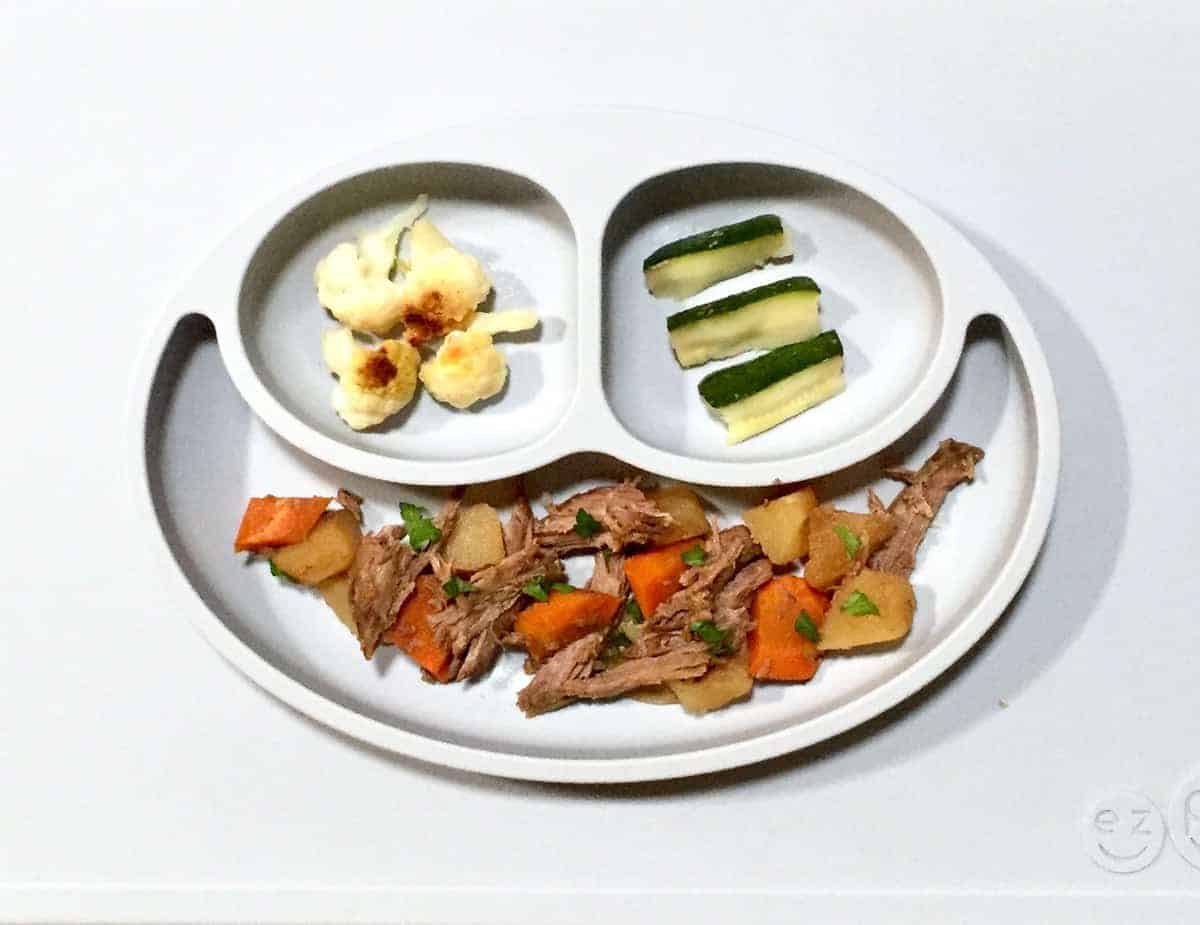
- Slow cooked/ pressure cooked: Such an effortless way to achieve that perfect level of tenderness and flavor in beef!
- Marinated: This extra step will help add flavor as well as make less tender cuts more tender. Use acidic ingredients, such as lemon juice, vinegar, or yogurt.
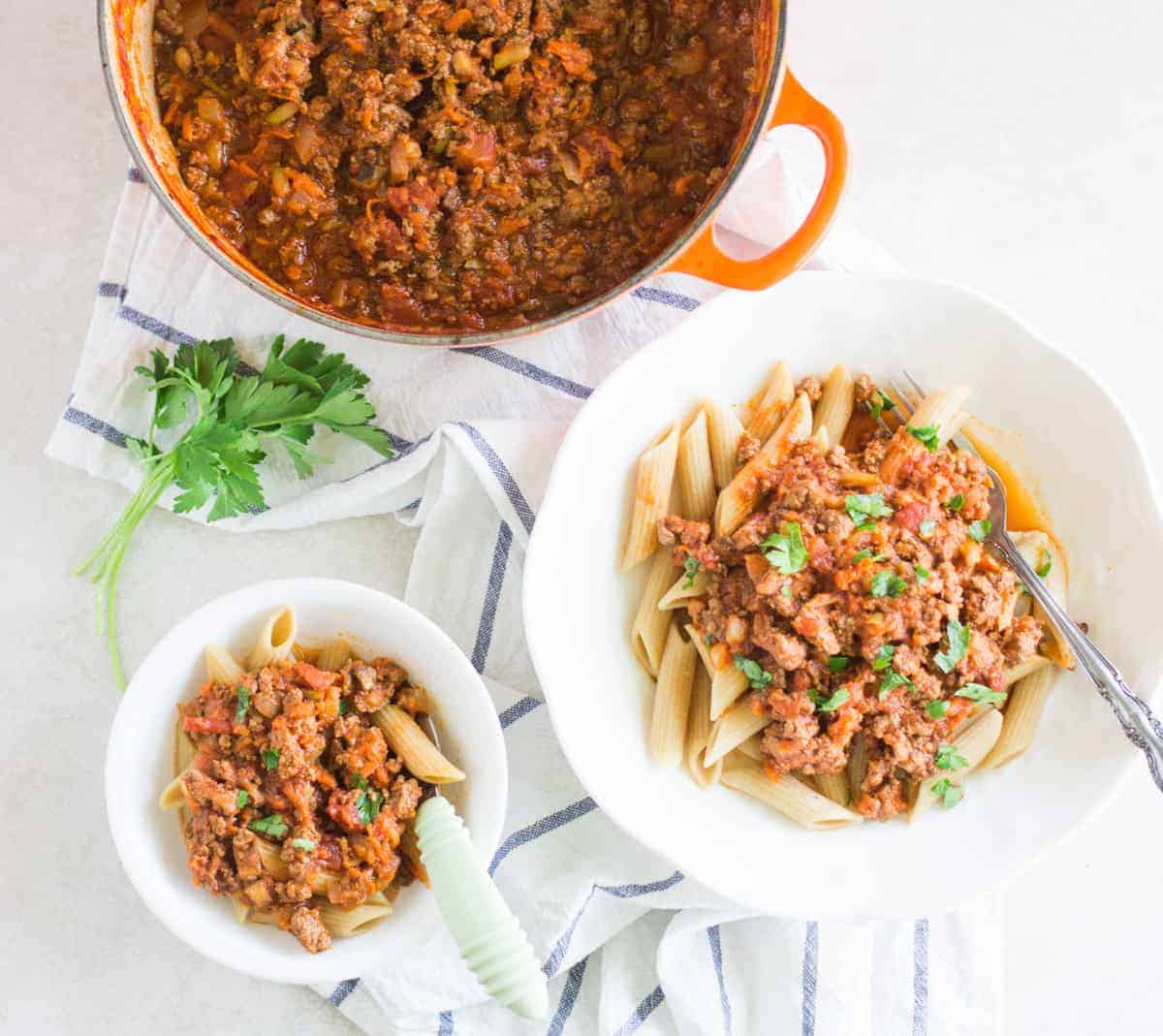

- Stew/soup: Add beef along with vegetables, broth, tomato sauce, spices, etc. and you’ve got a hearty one pot meal! You can deconstruct and serve the beef and vegetables without the liquid or if you’re feeling brave (which I want to breathe encouragement into you!), serve with the liquid. It will be messy but exploration and challenging them with new skills are important parts of self-feeding.
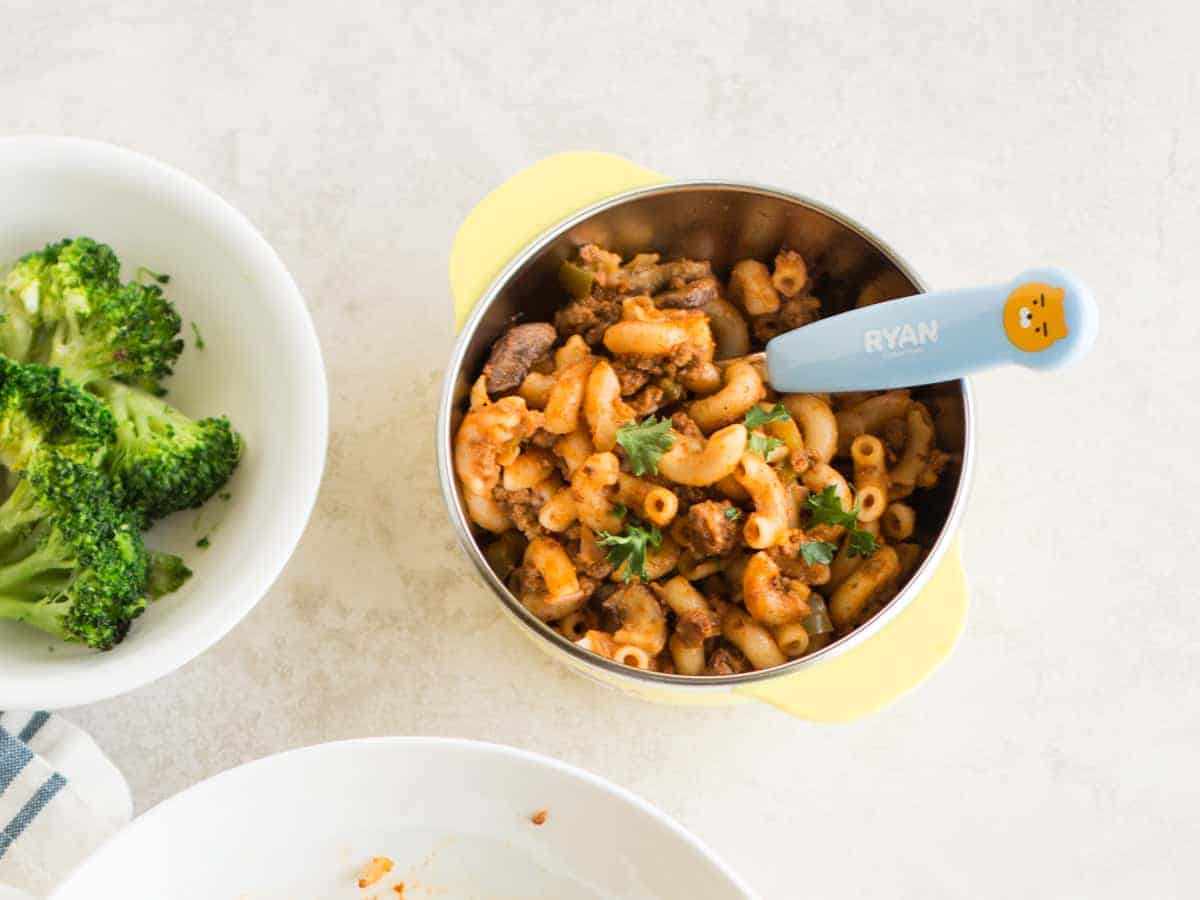
- One pot beef pasta/grain: Cook pasta/grain in sauce along with beef! Pasta releases starch as it cooks, making the sauce thick and creamy and the beef flavorful.

Do you want to minimize picky eating and set a solid foundation for a lifetime of healthy eating habits?
Check out this 3 month mastering self-feeding program! It’s the closest thing to me being in your kitchen

